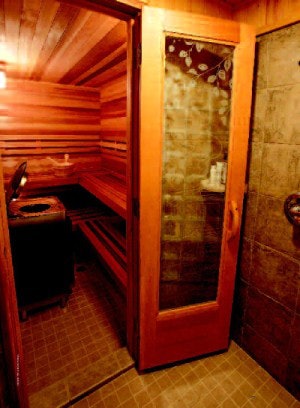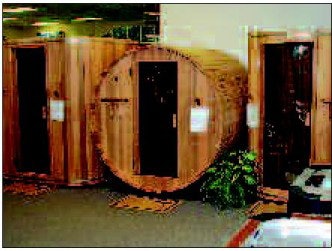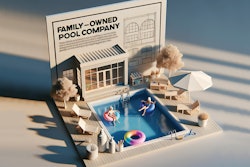
It probably comes as no surprise that sauna sales in this country lag far behind hot tub sales. On the other hand, sauna sales have historically flourished across the pond, while hot tub sales have lagged. So why are saunas so successful in Europe while they stand in the shadow of other home leisure products (specifically hot tubs) here.
What can dealers, and manufacturers, do about it. Should they do anything about it. AQUA discussed the differing American and European markets with a few manufacturers and dealers to discern what each party can do to make saunas a larger part of our national leisure lexicon.
Well, How Did We Get Here?
If there were a High Noon-style showdown between hot tubs and saunas in the United States, there's no question hot tubs would win, and vice versa if a grudge match was held in Helsinki. A combination of factors accounts for the reverse popularity of the two products.
Saunas were invented in Finland over 2,000 years ago, so it's natural that they have a stronger geographical foothold in Northern Europe. "We're just at the birth of the cycle for sauna compared to Europe," says Mark Raisanen, national sales manager for Finnleo Sauna & Steam. "I mean, in Europe, it's mainstream, people know what it is, every hotel and club is going to have them, and they're going to have a good model."
Hot tubs, on the other hand, began in the States, and so they enjoy a geographical advantage here. But there's more to the products' reverse popularity than geography. Saunas are an integral part of the social fabric in many Northern European countries, especially in their birthplace, Finland. Families and friends take a sauna together, mixed-sex groups as well as single sex, though the socialization is largely limited to companionship without conversation since saunas are usually a place of introspection, as well. In the United States, hot tubs largely occupy that social niche, according to Lee Eilers, executive vice president for sales, marketing and distribution for Great Lakes Home & Resort, which carries Almost Heaven saunas. "I believe the biggest reason hot tubs have taken off so much faster than saunas is I can look at a spa, and I can bring my family to the spa, and I can talk about how that's going to be a great experience for my family and for the kids and for their friends," he says. "So I can feel good about that purchase because it's something for the entire family. From a sauna standpoint, it just isn't near as active or social for a family."
If saunas are seen as mostly a health-related product and hot tubs are seen as a social product, with health benefits, are the two products even direct competitors. Opinions differ over whether customers will buy one or the other, or whether they will buy one of each. A hot tub dealer who's also a sauna expert may have the biggest advantage. "It's sometimes harder to close a customer on a hot tub, whereas a sauna sale, if the dealer is the expert, and they're the only one in town with multiple rooms on display, their close rate is much higher," says Raisanen. "Yes, they know hot tubs are their bread and butter, but they also know that they can strengthen their business — a lot of hot tub dealers are complaining about hot tub sales flattening out — and this is the best way for them to grow. They're not meant to compete with each other; they are meant to complement each other, and once dealers sell them that way, they're loving it."
Perhaps counterintuitively, some manufacturers feel more competition in the sauna market would help sell more units here. "There are a lot of manufacturers who helped create hot tub exposure here in the U.S., and right now in the U.S. there are so few sauna manufacturers, it would be great if there were 100," says Raisanen. "It would help the exposure everywhere, which is limited by your ad budgets, by your public relations budgets. In Europe, you've got thousands of dealers advertising saunas, and here in the U.S. you may have hundreds."
Though saunas may not become part of the broader cultural fabric here as they have in Northern Europe, both manufacturers and dealers agree that just means they'll have to work a little harder to get noticed, and the first step is education.
Getting Schooled
There is a Finnish saying that translates to, "If a disease can't be cured by booze, tar, or the sauna, it is fatal." Exactly what disease is cured by tar — or booze for that matter — remains a mystery, but dealers and manufacturers speak glowingly about the health benefits of taking a sauna, while simultaneously being very careful about what health claims are made. "Sauna in Finland is about hygiene," says Reino Tarkiainen, owner of Finlandia Sauna Products. "By taking one, it cleans your body deeper than the surface of the skin because it allows the sweating process, and by sweating, you get different toxins out of your body. And then you take the shower afterwards and it does clean your body, it gives you a good complexion. It's good for athletes who get sore from training, but it's not medical."
Educating both consumers and dealers about saunas, and about these health benefits, is perhaps the most important key to increasing sauna awareness in the United States, and probably the biggest difference between the two markets. "The European market is so far past us, in the cultural acceptance of saunas, they don't have to sell the marketplace on the value of a sauna, and we have to do that here," says Eilers. "So we're so far behind on the consumer acceptance curve compared to Europe that our job here is more of an education on the tremendous value and benefits of a sauna, first. And then you get into the aesthetics and the quality of the actual sauna that they're looking at."
One of the best ways to educate people about saunas is to get them to experience one for themselves. "People in Europe do a lot of traveling, and when you go to Finland, you can use saunas in a hotel and so they get educated pretty well," says Tarkiainen. "For American people who go to Finland as a tourist, they take a sauna; they usually are good customers."
Just as important as consumer education is dealer education about saunas. "First of all, dealers should learn what the sauna is. A lot of dealers don't know what it is — the dealers should buy a sauna for their own home, so they can learn about it and enjoy the sauna," says Tarkiainen. "It's easier for them to sell when they can honestly tell how they feel about a sauna. Then they can relate that enjoyment of the sauna to the customer, and give a very open, honest opinion."
In the States, lack of a lengthy tradition hinders understanding of what a sauna truly is, and the recent introduction of infrared heating cabinets has only served to muddle the mix even more. While infrared units are regularly called saunas here, that is not the case in Europe. Usually constructed of western red cedar, traditional saunas use heat and steam, while infrared units, as the name implies, use infrared light waves just below microwave frequencies in the light spectrum, to heat the body up to several centimeters below the skin without heating the air around it. For the purposes of this article, discussion is limited to traditional saunas, as they have a long historical presence in Europe that we can use as a benchmark for the States.
"In Europe, they don't have to explain what a sauna is," says Raisanen. "For instance, infrared in Europe, they don't call it a sauna; they call it a heat or infrared cabin. Everyone knows they're two different products. They have some similarities, but they are definitely not one and the same. Here in the U.S. it's a completely different story. You spend a lot of time explaining the differences, where over there people know the differences. We're trying to get the American market to that level, but it's difficult."
Whether you choose to sell the traditional saunas, or infrared heating units, or both, it's very important to know the difference so that you can pass along accurate information to your customers.
Marketing Magic
OK, you know what a sauna is, you know what it does, and you agree that educating the public will go a long way toward moving more units. So now what? First, since saunas are seen here as a health product, as opposed to a social product, it's only natural that most companies and dealers use this to market them. "We actually have a brand-new marketing piece that's devoted specifically to the health benefits of a sauna," says Raisanen. "That's been a part of our training since we've been in business: promoting the health side of sauna."
Giving saunas pride of place in your dealership is another important way to get them noticed. "One of the things that I think is most important is that we display the saunas; we have them in stock," says Stan Griffin, owner of Griffin Pools in Lexington, S.C. "If you're trying to show them a brochure about health benefits, it's something, but if you put those folks inside that sauna, let them smell the wood, get the feel of how it's going to be in there, that's definitely the most important thing. You have to have them in stock and on display for people to experience. We can turn them on, at the home show, we'll have them heated up, let people sit inside, feel it. Most people think that if you've got it set at 160 degrees, that it's just unbearable, but it's not once they sit in there for a few minutes."
Scott Prociv, owner of Montana Hot Spring Spas in Billings, Mont., agrees that a unique display and educating consumers and employees alike does wonders for sauna sales.
His dealership recently put five saunas on the showroom floor, which only takes up 800 square feet of a 6,500-square-foot dealership. "From what I've seen, a dealer buys one, puts it in the corner and thinks, or hopes, it will sell, versus displaying them and becoming knowledgeable and educated on how to teach people what the benefits are and how they can be easily installed into a house," he says.
Unique displays have also helped the dealership become more successful. "Get them in front of people's eyes; that's the key," says Prociv. "That's one reason why we're displaying an outdoor unit out on the street, which is very unique in our part of the country. People ask, 'What is that.' When people see a cabin sitting out there on the street, with a fire coming out of it on a cool day, it really puts out that awareness of what a sauna is."
It may seem obvious, but having at least one salesperson who specializes in saunas will greatly increase your chances of selling them. "When customers go into one of our dealer showrooms, and they are saying, 'I don't know if I want a sauna or a hot tub,' my guess is a lot of the showrooms, they know hot tubs, so they're probably going to steer the customer towards the spa because that's what the salesperson is comfortable with," says Raisanen. "Now our best showrooms, where they're doing huge numbers of saunas, then they're going to ask a lot more questions to try and find out how the customer is going to use it."
Manufacturers also recognize their role in promoting saunas. "Health benefits to consumers sticks in their heads, but you first have to get them to ask about it," says Raisanen. "Getting them to ask is prompting them with everything from TV commercials, which we produce, to print ads, to dealers with a nice display, to home shows. To raise awareness of sauna, you have to bring it out, bring it to the people. You go back 20 years ago in the hot tub industry; everyone was going to home shows and fairs and beating the drum. Well now the same thing is happening with saunas."
Know Your Customer
Another key to selling more saunas is figuring out whom to sell them to. The target customer in Europe is, well, everybody. "In Europe, everybody buys a sauna pretty much, not in every country, but in Scandinavia and Russia. In Finland, there's a sauna for every home, and in Sweden saunas are very popular, too," adds Tarkiainen. Here, sauna buyers tend to be more demographically homogeneous, but luckily, it's a familiar group. "The average age of people buying a sauna is 44, typical homeowner income is $75,000- plus, they are very health oriented and typically have a family," says Raisanen. "If you take any spa company and compare their demographics to ours, there will be so many similarities. A lot of them may own health and fitness equipment and other hearth products as well. That's why a pool and spa showroom is the perfect place to sell saunas. The people coming in are already your buyers; they're the ones who want to add the saunas."
Though the two buying groups overlap, there are definitely some differences as well, with the sauna buyer tending toward more health-conscious pursuits. "It's a more defined market for saunas than spas," says Griffin. "You've got to educate the consumer, and not everyone's interested in that. Very few times do they come in specifically looking for a sauna. Most of the time they're driven by something else that we sell, and they say, 'Oh, you've got saunas,' and we explain the benefits to them. That's how we sell most of the saunas that we do. The average person that buys them is very athletic. They either work out, or they jog; they want it more for health benefits than anything else."
In It For The Long Haul
Well, will sauna dealers ever join hands across the ocean and sing a rousing chorus of "Kumbaya". Our market is really in its infancy compared to the European one. "We've got good dealers, and we're going to let them run with it, but this is a product that we know we're going to be hanging with for quite a period of time while that acceptance curve continues to get stronger here in the States," says Eilers. "But we're in it for the long haul, and I think you have to be in order to make this a product you want to market, because the market will take a while to grow." Help the market grow by planting the seeds of interest in your customers. Send out literature about saunas. Try one yourself. Give saunas a little loving and see if they don't love you back.
"When you give saunas attention, they're easy to sell," says Raisanen. "You consider it a legitimate product category, you give it attention, and dealers are surprised at how well they sell. We have dealers who decided, 'I'm going to give it a try, put up a little nicer display. I'm going to advertise it a little. I'm going to do it just like my hot tubs and pools,' and they can't believe the sales. That's what the Europeans already do, and that's what we're trying to get the American dealer to do — just realize saunas are legitimate, that they are going to be here and that they want to be the player in their town."








































